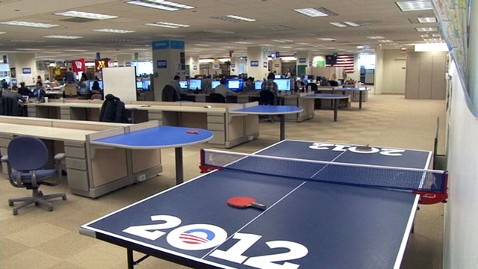Inside Obama Campaign Headquarters: Confident Urgency and an Empty Keg

ABC News’ Devin Dwyer and Michael Falcone report:
CHICAGO – On a recent Friday afternoon, the 2012-themed ping pong, foosball, and air hockey tables sit idle inside President Obama’s 50,000-square-foot re-election headquarters.
The staff of 200-plus mostly twenty-somethings are spread across a floor of One Prudential Plaza, huddled around white boards and hunched over rows of sleek new laptops.
They’re busy making a play for a much more consequential game.
With the presidential election less than a year away, Obama’s campaign team is orchestrating what it calls the most technologically advanced and strategically focused effort by any candidate for the White House. And the team is brimming with confidence that it will succeed.
“I feel really good about all the possible paths to victory,” said campaign manager Jim Messina.
From the Chicago perch – thought to be the first presidential re-elect run from outside of Washington, D.C. – Obama campaign aides are content with a drawn-out Republican primary, welcoming more time to beef up Obama’s volunteer network and rekindle a sense of urgency on the ground.
In a dimly-lit corner of the office, a cadre of web designers and computer engineers are quietly putting the finishing touches on the “Obama 2012 Dashboard” – a proprietary social media platform that, they say, will for the first time allow supporters to “join, connect with, and build your neighborhood team online” when it’s rolled out.
Across the hall, a department of specialized organizers has set into motion an aggressive micro-targeting effort the campaign has branded as “Operation Vote,” which is aimed at courting relationships with members of key voter constituencies such as women, Latinos, African-Americans and gays.

“We scratched the surface on that in 2008 but we didn’t really have time,” said Jeremy Bird, the campaign’s national field director. Aides say organizers are even trying to tailor their outreach to tiny ethnic communities in key swing counties, citing Ethiopians in Northern Virginia as one example.
Bird said an intricate campaign hierarchy — known internally as the “snowflake” model — connects millions of Obama supporters from neighborhood blocks across America, through state offices to regional teams and the Chicago nerve center. And it’s already appearing to bear fruit.
The campaign has enlisted more than 1,000 neighborhood team leaders, hundreds of thousands of volunteers, held more than 1 million in-person conversations between organizers and voters, and raked in more than $88 million in campaign cash, much of it coming directly from the grassroots.
But with the growth has come challenges.
“A lot of people we reach say, ‘Of course, I’m with you, but last time I didn’t start until June,’” Bird said of a common response in the field. “So we’re pushing greater understanding of the fact that what we do now builds on itself.”
Bird, who already receives a daily electronic report from each state field director, said organizers are also training volunteers as ambassadors for an unpopular president, teaching them how to rattle off the president’s accomplishments and defend his vision where economic pessimism abounds.
“I think we have a lot of room to grow to be bigger and better and more sophisticated than last time,” Bird said.
Obama for America nearly doubled the size of its staff on payroll in the summer, growing from 168 employees in July to 327 as of Sept. 30, according to the campaign’s third quarter financial report. At this point four years ago, Obama hadn’t yet clinched the Democratic nomination, much less establish a nationwide campaign staff.
And with the current office space at roughly half-capacity, campaign officials expect the team to double in size once more by early next year, adding more researchers, media monitors, grassroots organizers and administrative staff.
For now, the empty rows of desk tables play host to jumbles of supplies, empty take-out food containers and a couple of expired aluminum beer kegs, signs that the vibrancy of the young Obama team is not all lost in the seriousness of the task at hand.
“This place feels like half Fortune 500 company, half start-up,” one staffer said of the campaign’s vibe. But come Nov. 6, 2012, he predicted, the Obama venture will still be going strong.